Botswana Travel Destinations and Vacations
Help Me Plan- Home
- >
- African Travel
- >
- Botswana
Botswana Destination Guide
We highlight important considerations when planning a vacation to Botswana, one of Africa’s most pristine and exclusive safari destinations.
Getting to Botswana
After arriving in Johannesburg, guests fly to either Maun or Kasane in Botswana. Known as Botswana's tourism capital, Maun is the entry point for most safaris due to its proximity to the prolific Okavango Delta. Kasane is in the northeastern corner of Botswana, close to the Kazungula border post, where four countries meet—Botswana, Zambia, Zimbabwe, and Namibia. This location makes the town an ideal access point for safaris to Chobe National Park, the Okavango Delta, Namibia's Caprivi Strip, and even Victoria Falls.
Weather & Best Time to Visit
- December to March (Emerald Season): Warm (min. temps in low 20s °C), with a mix of sunshine, thunderstorms, and overcast days. Lush landscapes but more rain.
- April to May: Pleasant, clear skies, green scenery. Cooler evenings, especially in the Kalahari.
- June to August (Peak Safari Season): Dry, sunny days with cold nights (near freezing in drier areas). Excellent wildlife viewing as animals gather at limited water sources.
- September to October (Best Game Viewing): Hot, dry conditions concentrate wildlife further. September is more comfortable; October can be extremely hot (up to 40 °C).
- November: Transitional month; can be hot like October or cooled by early rains.
Visa Information
Botswana has an e-Visa system launched in August 2021, allowing eligible travelers to apply, upload documentation, and track application status online. Official Botswana Visa Information and Application Process.
Medical Considerations
While the southern half of Botswana—home to safari areas like Kgalagadi and the Central Kalahari—is considered a low-risk malaria area, the popular wildernesses of northern Botswana are high-risk. Consult your physician regarding anti-malarial medication. We do not recommend traveling to Botswana with small children. Most camps provide mosquito repellent, but it is always convenient to have some of your own.
No vaccinations are required. It is strongly recommended that you are up to date with routine vaccinations like measles-mumps-rubella (MMR), diphtheria-tetanus-pertussis, varicella (chickenpox), polio, and your yearly flu shot. There is no risk of yellow fever in Botswana. Proof of yellow fever vaccination is required only if you arrive from, or have transited through, a country with risk of yellow fever transmission.
Safety
Surrounded as they are by spectacular wilderness, petty crime at Botswana's remote safari camps is hardly an issue. Nevertheless, be discreet with valuables. If you are traveling with items of considerable value, confine them to your in-room safe or ask reception to look after them for your stay.
Traveling Around
While traveling in Botswana, your transportation will typically take the form of modified open-air 4x4 vehicles. These vehicles are used on game drives and for transfers from the airstrip to the lodge—for example, when enjoying a safari in Chobe National Park.
Charter flights in light aircraft will be required if your safari takes you further afield to indelibly wild areas like the Okavango Delta, Savute, or Linyanti. Keep in mind that this generally augments the price of any safari in Botswana and that particular luggage restrictions apply on charter flights.
Top Travel Destinations in Botswana
Botswana is a wild land of contrasts, with a rich diversity of safari areas scattered throughout one of Africa's most sparsely populated countries.
Chobe in northeastern Botswana is one of the African continent's most unspoiled conservation areas.
A world of water, wildlife, and islands awaits those who travel to the most revered safari destination in Botswana.
Makgadikgadi isn’t for everyone, but its surreal landscape offers safaris that thrill die-hard enthusiasts.
Botswana Vacation Options & Travel Tips
Unforgettable encounters in authentic wilderness areas characterize the safari vacations you can enjoy in Botswana. The game viewing is sure to be top-notch.

Tours, Safaris & Honeymoons
Browse our thoughtfully crafted safari tours.

Tailor-Made Vacation Packages
All our tours and safaris can be customized.

Travel Tips & Advice
Important information about visiting Southern Africa.
Other Recommended Travel Destinations in Botswana
Though not as well known nor as popular as the destinations listed above, each of Botswana's other destinations offers genuinely unique and exciting safari endeavors.

Central Kalahari
One of the world’s largest reserves (≈52,800 km²): vast plains, red sands, abundant predators, and deep remoteness.

Moremi Game Reserve
Verdant Okavango habitats with rich wildlife, ~500 bird species, and the famed Chief’s Island.
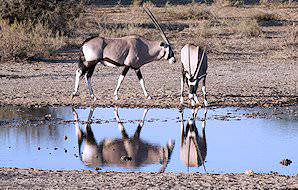
Kgalagadi Transfrontier Park
Cross-border desert of dunes and fossil riverbeds; look for black-maned lions, oryx, and sweeping skies.
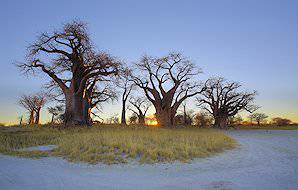
Nxai Pan
Salt-pan scenery, seasonal migrations, big predators, and the iconic Baines Baobabs.
Botswana Travel Video & Facts
Those who travel to Botswana will be captivated by the beauty of its wilderness and the hospitality of its people.
Botswana has more than 17% of its land dedicated to protected wildlife areas, including national parks and game reserves. Notable conservation areas include Chobe National Park, the Okavango Delta, the Makgadikgadi Pans, Savute Marsh, the Kgalagadi, and the Central Kalahari—one of the largest game reserves in the world. It is a paradise for nature lovers.
Unforgettable Wildlife Encounters
Botswana is one of the world’s premier safari destinations, offering rare and intimate moments with Africa’s wildlife. Every day brings a chance to witness nature at its most raw and spectacular.
- Elephants crossing the Chobe River at sunset.
- Mokoro rides past hippos and crocs.
- Tracking black-maned lions in the Kalahari.
- Wild dog hunts in Moremi.
- Zebra and wildebeest migrations on the pans.
- Leopards and cheetahs on dawn drives.
- Flocks of flamingos and pelicans.
- Rare antelope like roan and sable.
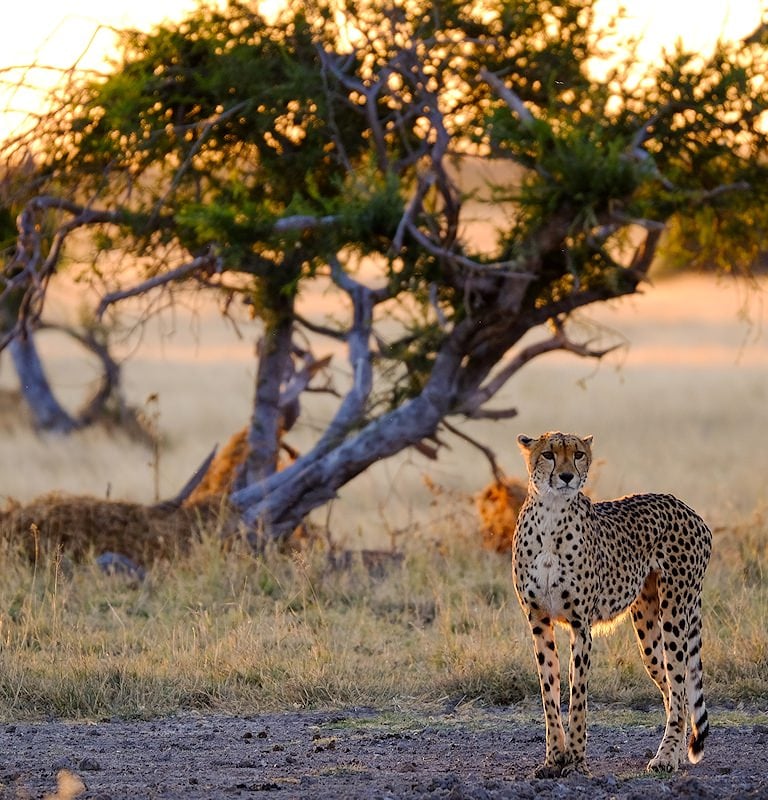
Foods To Try in Botswana
When visiting a country or area, it is always a good idea to try some local delicacies.
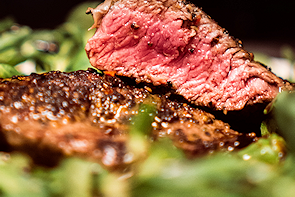
Steak
Botswana is cattle country, famous for its high-quality beef. Expect one of the most succulent steaks imaginable on your safari lodge's menu.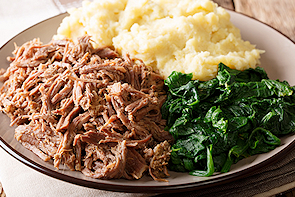
Seswaa
The country's national dish, seswaa, is typically made from beef or goat. The meat is stewed in a traditional pot with only salt and water, then served with polenta or pap and morogo—the leafy green often called “African spinach.”
Watermelon
Watermelons originated in Southern Africa and grow wild in the Kalahari. In season, you are sure to find this delicious fruit on the breakfast table, as a refreshing snack, or as an addition to a summery salad.
Mopane Worms
Adventurous spirits may try mopane worms—large, edible caterpillars cooked in hot ashes, boiled or dried, and fried. This delicacy is an accessible and vital protein to millions of Southern Africans.Botswana Travel FAQ
Coverage is good in towns like Maun, Kasane, and Gaborone, but most safari camps are intentionally remote and may have limited or no signal. Many camps now offer Wi-Fi in main areas, but expect a digital detox — a highlight for many travelers.
Yes. Most lodges provide complimentary bottled water or filtered drinking water. In towns and cities, bottled water is widely sold, and tap water is generally safe in urban centers.
While wildlife encounters are thrilling, they require respect. Follow your guide’s instructions at all times, avoid walking unaccompanied at night in camp, and never feed or approach animals.
Activities vary by lodge and region. Popular options include open-vehicle game drives, guided bush walks, mokoro excursions, motorboat cruises, birding, and night drives in private concessions. Your itinerary can be tailored to include a mix.
Yes — rhino conservation efforts have been successful, with white and black rhinos reintroduced to secure areas such as Chief’s Island in the Moremi Game Reserve. Sightings are still special and not guaranteed.
Botswana borders Namibia, South Africa, Zimbabwe, and Zambia — with a unique four-country meeting point at Kazungula, where you can visit several destinations in a single trip.
Yes. Most camps can cater for vegetarian, vegan, gluten-free, and other dietary requirements with prior notice. Let African Sky know your preferences when booking so kitchens can prepare accordingly.
Lodge staff usually confirm departure times the day before you travel. Charter flights are often scheduled to coordinate with your safari activities and onward connections.
The Central Kalahari Game Reserve, covering about 52,800 km², is Southern Africa’s largest protected area. It offers some of the most remote and exclusive safaris on the continent.
Botswana follows a high-value, low-impact tourism model. Remote luxury camps, charter flights, and conservation levies mean safaris here cost more than in most countries — but the exclusivity, low visitor numbers, and exceptional game viewing make it worthwhile.
Safari Activities

Bush Walks
Bush walks are conducted in several reserves in Botswana, including Chobe, the Okavango Delta, Khutse, and the Central Kalahari. The Okavango Delta offers some of Africa's most unique walking safaris; guests often take a morning boat ride to an uninhabited island and then explore on foot with a ranger and tracker. These walks can offer views of elephants crossing channels, large buffalo herds, and, with luck, aquatic antelope like lechwe and sitatunga.

Mokoro Trips
The Okavango Delta is synonymous with “mokoro” trips—gliding along shallow waterways in a dugout canoe propelled by a single poler. It’s a silent, peaceful way to spot species along reed-lined channels. (It can also be an adrenaline rush if large wildlife is encountered.)

Game Drives
The most common way of viewing wildlife in the Okavango is on 4x4 vehicle game drives, typically in the early morning and late afternoon from lodges with access to larger land areas. Specially adapted Toyota Land Cruisers are often used, with local rangers and trackers providing insight into animal behavior.

Spa Treatments
Many luxury lodges in Botswana offer spa treatments to indulge the senses and relax body and mind—often on a private deck with magnificent views and the natural soundtrack of the African wild.

Fishing
Many lodges in Botswana offer both conventional and fly-fishing for indigenous species. The notorious tigerfish is a highlight among freshwater fighting fish; other species include bream and catfish. The best time for fishing in Botswana is from late August to mid-November.
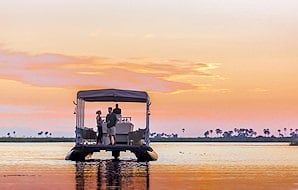
Sunset Cruises
The Chobe River, forming Botswana’s northern border, offers some of Africa's grandest sunset cruises. Late-afternoon boats—departing from or near Kasane—often encounter large herds of elephants and a great diversity of birdlife. Photographers will find exceptional opportunities.
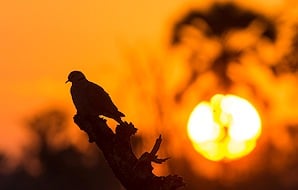
Bird Watching
Botswana is a birder's paradise, with 593 identified species, around 100 of which are rare or accidental. Whether you choose Chobe or the Okavango Delta, the birding is outstanding.
The People
Primary Tribal Group
The Tswana are Botswana's most significant tribal group, comprising almost half of the population, followed by the Bakalanga, who inhabit the northeast and central districts and have lived there for nearly a thousand years.
The Riverine Tribes
The riverine tribes of the Bayei, Basubiya, and Hambukushu inhabit the Okavango and Chobe waterways in Ngamiland, subsisting on the waters and their natural resources. The Bayei arrived in the 1700s, closely followed by the Basubiya, who established settlements along the Chobe River.
The Hambukushu
The Hambukushu are master basket weavers and more recent additions to Botswana’s cultural tapestry. They arrived in waves from Namibia and Angola over the past couple of centuries, with the last large group moving in 1969 to escape the Angolan civil war.
Bakgalagadi Tribe
The Bakgalagadi are of Sotho-Tswana origin and closely related to the Batswana, sharing similar customs and beliefs. Many Bakgalagadi still practice subsistence agriculture. The San are also deep rural dwellers who often prefer minimal contact with larger settlements.
Sites of Interest
Tsodilo Hills
The Tsodilo Hills rise about 400 m (1,312 ft) above the surrounding plains and are visible from the Okavango Delta more than 50 km (31 miles) away. They are one of the world's most important rock-art sites, with as many as 3,500 individual paintings spanning over 25,000 years of near-continuous habitation.
Drotsky's Caves
Situated in the Kalahari Desert, around 50 km east of the Aha Hills, Drotsky's Caves—also known as the Gcwihaba Caves—form one of Botswana's most beautiful and unusual national monuments. Easy to miss among undulating dunes, they hide a spectacular labyrinth below.
Flow-stone draperies, frozen “waterfalls,” and mammoth natural obelisks fill sweeping hallways and chambers—some up to 10 meters high. Beautiful inlets and apertures, awash in subtle light and color, showcase the passage of time in all its petrified glory.
Geography
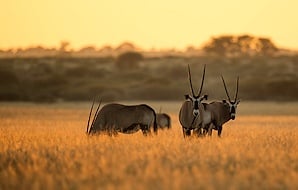
Kalahari Desert
Stretching through nine degrees of latitude, more than half of Botswana lies within the tropics, yet it is drier than most tropical countries and prone to drought. The boundless Kalahari—the world's largest unbroken stretch of sand—covers about 84% of Botswana, extending from the Orange River in South Africa to near the equator in Gabon.

Okavango Delta
While Botswana is often depicted as flat, featureless semidesert, its landscapes hold incredible variety. The greatest paradox is the lush jewel of the Okavango Delta, formed where the wide, fast-flowing Okavango River spreads across the sands and soaks away—vanishing in its futile search for the sea.
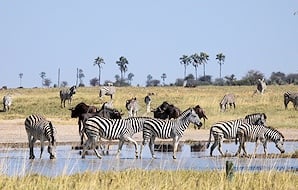
Makgadikgadi Pans
Other remarkable features punctuating Botswana's terrain include the immense Makgadikgadi Pans, whose salt-cracked surface marks the deathbed of the ancient Lake Makgadikgadi. Along the eastern edge of the country, hills and koppies add variety; far to the west and southwest, deep in the Kalahari, the terrain is flat and arid.












